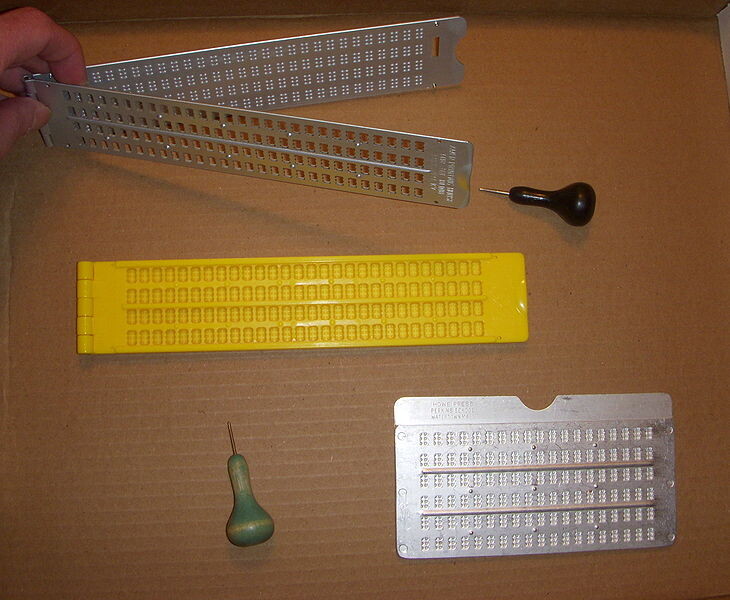In 1821, a blind Frenchman named Louis Braille devised a tactile system for blind people to read. Called Braille, the system was a series of characters, or "cells," made up of six raised dots arranged in a rectangle containing two columns of three dots each. The pattern arrangements correspond to letters of the written alphabet, and each cell is read using the fingers.
The Alphabet and Braille Character Equivalents

- a= dot 1
- b= dots 1 and 2
- c= dots 1 and 4
- d= dots 1, 4, 5
- e= dots 1 and 5
- f= dots1,2, 4
- g= dots 1,2, 4, 5
- h= dots 1, 2, 5
- i= dots 2 and 4
- j= dots 2, 4, 5
- k= dots 1 and 3
- l= dots 1, 2, 3
- m= dots 1, 3, 4
- n= dots 1, 3, 4, 5
- o= dots 1, 3, 5
- p= dots 1, 2, 3, 4
- q= dots 1, 2, 3, 4, 5
- r= dots 1, 2, 3, 5
- s= dots 2, 3, 4
- t= dots 2, 3, 4, 5
- u= dots 1, 3, 6
- v= dots 1, 2, 3, 6
- w= dots 2, 4, 5, 6
- x= dots 1, 3, 4, 6
- y= dots 1, 3, 4, 5, 6
- z= dots 1, 3, 5, 6
Reading Braille
People read Braille by moving their fingertips from left to right across the lines of dots. Developed in the early 1800s by Louis Braille, Braille is a series of characters, or "cells," that are made up of six raised dot patterns, arranged in a rectangle containing two columns of three dots each. The pattern arrangement corresponds to letters of the written alphabet.
A sample braille cell, showing the location of dots 1 through 6.

The basic Braille code is called Grade 1 Braille and is a direct substitution of normal print letters for letters from the Braille alphabet. Grade 2 is a shorter form where certain letter combinations and other frequently used short words are given an abbreviated Braille pattern. These abbreviations make reading and writing Braille much faster.
Writing Braille
The slate and stylus are the tools used to write braille. A slate is a metal or plastic guide that opens with a hinge on one end. A slate can come in different shapes and sizes. A stylus is a small tool about 3 inches long, with a metal point at one end and a wooden knob or plastic handle at the other end.
A card-stock paper is inserted into the slate, and the stylus is used to punch holes in the paper. The holes that are punched are the raised dots that will be read by touch. A slate and stylus can be compared to paper and pencil.
When you write with paper and pencil, you write from left to right, and you write the letters just as they will be read. When you write Braille, you must write the cells in reverse order and you also must write letters from right to left so when you remove the paper from the slate and flip it over to read the raised dots, the Braille cells will be in the correct orientation and order to properly read them .
For more information on Louis Braille please visit these sites:
